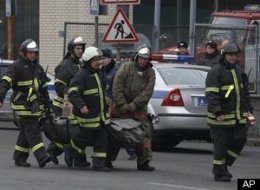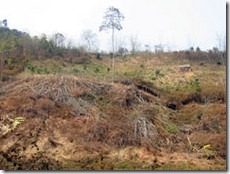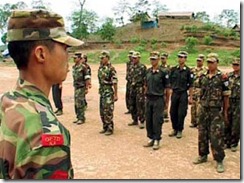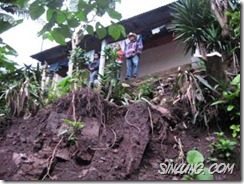
Photos taken around the scene of the Moscow subway attack.
Moscow, Mar 30 : Terror returned to the heart of Russia, with two deadly suicide bombings on the Moscow subway at rush hour, including an attack at the station beneath the headquarters of the secret police.
At least 38 people were killed and more than 60 wounded in Monday morning's blasts, the first such attacks in Moscow in six years.
Russian police have killed several Islamic militant leaders in the North Caucasus recently, including one last week in the Kabardino-Balkariya region, which raised fears of retaliatory strikes and escalating bloodshed by the militants.
As smoke billowed through the subway tunnels not far from the Kremlin and dazed survivors streamed out of the vast transportation system, al-Qaida-affiliated Web sites were abuzz with celebration of the attacks by the two female suicide bombers.
The bombings showed that the beleaguered rebels are still strong enough to inflict harm on an increasingly assertive Russia, and they followed a warning last month from Chechen rebel leader Doku Umarov that "the war is coming to their cities."
Prime Minister Vladimir Putin, who built much of his political capital by directing a fierce war against Chechen separatists a decade ago, promised to track down and kill the organizers of what he called a "disgusting" crime.
"The terrorists will be destroyed," he said on national television.
In a televised meeting with President Dmitry Medvedev, Federal Security Service head Alexander Bortnikov said the remains of the two bombers pointed to a Caucasus connection. "We will continue the fight against terrorism unswervingly and to the end," Medvedev said.
Umarov, the Chechen rebel leader, has relied on al-Qaida's financial support and has several al-Qaida emissaries in his entourage, said Alexander Ignatenko, the head of the independent Moscow-based Institute for Religion and Politics, who has closely followed the Islamic insurgency in the Caucasus.
"Al-Qaida has established a presence in the North Caucasus, like they did in Afghanistan, Pakistan, Iraq, Somalia and Europe," Ignatenko told The Associated Press. The militants' links with al-Qaida also are recognized by other experts on terrorism.
Militants in the Caucasus have declared the creation of an Islamic state as their top goal. Radical Islamic sects have spread throughout the Caucasus region and parts of Russia as well, with religious schools set up. In Chechnya, Kremlin-backed strongman Ramzan Kadyrov has conducted a campaign to impose Islamic values in an effort to blunt the appeal of hard-line Islamic separatists.
Monday's first explosion took place just before 8 a.m. at the Lubyanka station in central Moscow, beneath the notorious headquarters of the Federal Security Service or FSB, the KGB's main successor agency. The FSB is a symbol of power under Putin, a former KGB officer who headed the agency before his election as president in 2000.
About 45 minutes later, a second blast hit the Park Kultury station on the same subway line, which is near renowned Gorky Park. In both cases, the bombs were detonated as the trains pulled into the stations and the doors were opening.
"I was getting off the train when I heard the sound of an explosion and saw clouds of smoke," said Yegor Barbatunov, 29. "The (Park Kultury) station was jammed with people trying to get out, but there was no panic. I saw a young man walking past, blood pouring off his head and neck and trickling to the floor."
Added Alevtina Rogatova, a 23-year-old student who was on the same train: "I smelled burning plastic and heard cries of 'let the wounded through.'"
Amateur video on Russian TV showed wounded and possibly dead commuters on the floor of the smoke-filled Lubyanka station. One video showed gruesome images of dead passengers sprawled inside a mangled subway car and a bloody leg lying on a station platform.
Passengers streamed out of the stations, many crying and making frantic calls on cell phones. The wounded were put on ambulances and helicopters, some with their heads wrapped in bloody bandages, as sirens wailed.
Traffic was paralyzed as large sections of downtown were closed off. Some gypsy cab drivers jacked up their rates for panicky passengers trying to get to work, drawing a harsh rebuke from Orthodox Patriarch Kirill later in the day.
"Any desire to profit on the grief of others brings nothing but grief in return," Patriarch Kirill said after a liturgy.
At 4 p.m., the two subway stations reopened and dozens boarded waiting trains.
"It's really terrifying," said Vasily Vlastinin, 16. "It's become dangerous to ride the metro, but I'll keep taking the metro. You have to get to school, to college, to work somehow."
Both stations had been scrubbed clean. Holes left by shrapnel in the granite were the only reminder of the day's tragic bombings.
The ornate Moscow subway system is the world's second-busiest after Tokyo's, carrying around 7 million passengers on an average workday, and is a key element in running the sprawling and traffic-choked city.
The last confirmed terrorist attack in Moscow was in August 2004, when a suicide bomber blew herself up outside a subway station, killing 10 people. Chechen rebels claimed responsibility.
In February 2004, a suicide bomber from the North Caucasus attacked a subway train during the morning rush hour, killing more than 40 people and wounding more than 100.
Dozens of contributors to three Web sites affiliated with al-Qaida wrote comments in praise of Monday's attacks. One site opened a special page to "receive congratulations" for the Chechen rebels who "started the dark tunnel attacks in the apostate countries," and all wished for God to accept the two women as martyrs.
"Don't forget Russia's crimes of genocide in the Caucasus and Chechnya," said one writer. "The battle has been shifted to the heart of Moscow," another wrote.
Ignatenko said Islamic militants in the Caucasus often recruit women whose relatives were killed by Russian security services.
"They tell them that if they become martyrs, they will join their husbands, brothers and fathers," he said. "And they also persuade them that the Russians as a nation share a collective guilt."
While the Russian army battered Chechen rebels a decade ago, the separatists continue to move through the region's mountains and forests with comparative ease despite security sweeps by federal forces and police under the control of local leaders loyal to the Kremlin.
Rights groups say that abductions, torture and killings of young men suspected of militant links by Russian security forces have helped swell the rebels' ranks.
World leaders, including President Barack Obama, condemned the subway attacks. Obama telephoned Medvedev to convey the condolences of the United States.
New York increased security in its transportation network with officers assigned to subways overnight held in place so they overlapped with the day tour. Special units also were assigned to transit facilities. Washington, D.C., Metro police conducted random inspections of stations and rail yards. Atlanta's public transit system said its police department was increasing the number of officers and patrols in the system.
In London and Madrid, two cities hit by terrorist attacks, officials said there were no immediate plans to tighten security.
 Guwahati, Mar 31 : Traditional land clearing for planting of hill rice and vegetables (jhum) in Northeast India is now a part-time job.
Guwahati, Mar 31 : Traditional land clearing for planting of hill rice and vegetables (jhum) in Northeast India is now a part-time job. 





 Aizawl, Mar 31 : The Mizoram Government has submitted a road map for the repatriation of Bru refugees from Tripura which the Ministry of Home Affairs has accepted in principle, Home Minister R Lalzirliana said today.
Aizawl, Mar 31 : The Mizoram Government has submitted a road map for the repatriation of Bru refugees from Tripura which the Ministry of Home Affairs has accepted in principle, Home Minister R Lalzirliana said today.

 Or, why does the media give so little space to this vast region?
Or, why does the media give so little space to this vast region? 


